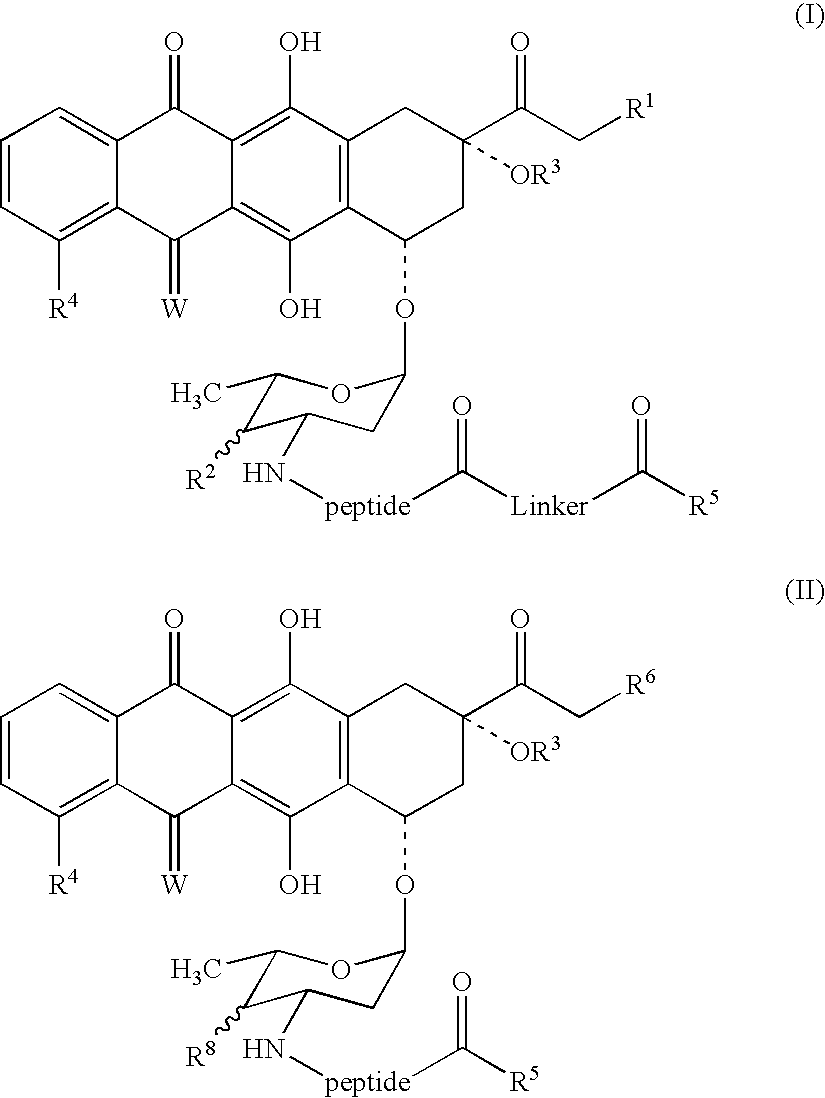Tetracyclic anthraquinones possessing Anti-cancer properties
a technology of tetracyclic anthraquinones and anti-cancer properties, which is applied in the field of tetracyclic anthraquinones, can solve the problems of limited clinical use of tetracyclic anthraquinones, weak side effects, and low selectivity, and achieves low toxicity, high efficacy and low toxicity of anticancer drugs
- Summary
- Abstract
- Description
- Claims
- Application Information
AI Technical Summary
Benefits of technology
Problems solved by technology
Method used
Image
Examples
example 1
Tert-butyl 2-(2-hydroxyethoxy)ethylcarbamate
[0160]In a three-necked flask (1000 mL) equipped with a mechanical stirrer, 52.5 g (500 mmol) of diglycolamine and 200 mL of chloroform were dissolved and cooled to 20° C. on an ice-water bath. To the flask, a mixture prepared by dissolving 109 g (500 mmol) of (Boc)2O in 200 mL of chloroform was added with stirring. The resultant solution was stirred overnight at room temperature. After reaction completion, 400 mL of water were added, and the organic and aqueous phases were allowed to separate. The resultant organic phase was removed, washed with water twice, saturated brine twice, dried over anhydrous MgSO4, filtered, and vacuum dried to yield 99.607 g of the title compound 1.
example 2
2-(2-(tert-butoxycarbonylamino)ethoxy)ethyl 4-methylbenzenesulfonate
[0161]To a three-necked flask (500 mL) equipped with a mechanical stirrer, 99.607 g of the compound 1 and 102.0 g of p-toluenesulfonyl chloride were added, and the resultant solution was cooled to 15° C. on an ice-water bath. To the flask, 160 mL of 20% NaOH aqueous solution was added. The resultant solution was stirred overnight at room temperature and then extracted with ethyl acetate three times. The resultant organic phases were combined, washed with saturated brine once, dried over anhydrous MgSO4, filtered, and dried to yield 150.258 g of the title compound 2.
example 3
Tert-butyl 2-(2-(1,3-dioxoisoindolin-2-yl)ethoxy)ethylcarbamate
[0162]To a one-necked flask (250 mL), 87.689 g (244.2 mmol) of the compound 2, 67.766 g (366.3 mmol) of potassium phthalimide, and 150 mL of anhydrous DMF were added and first stirred at room temperature for 1 hour, then stirred overnight at 55° C. After the reaction, 2000 mL of water was added, and the resultant solution was extracted with ethyl acetate three times. The organic phases were combined, washed with water twice, 5% NaOH once, saturated brine twice, dried over anhydrous MgSO4, filtered, and dried to yield 62.192 g of the title compound 3. 1H NMR: δ 7.831 (m, 2H), δ 7.702 (m, 2H), δ 4.915 (s, 1H), δ 4.099 (t, 2H), δ 3.866 (t, 2H), δ 3.669 (t, 2H), δ 3.500 (t, 2H), δ 3.238 (t, 2H), δ 1.389 (s, 9H).
PUM
| Property | Measurement | Unit |
|---|---|---|
| solubility | aaaaa | aaaaa |
| temperature | aaaaa | aaaaa |
| pharmaceutical composition | aaaaa | aaaaa |
Abstract
Description
Claims
Application Information
 Login to View More
Login to View More - R&D
- Intellectual Property
- Life Sciences
- Materials
- Tech Scout
- Unparalleled Data Quality
- Higher Quality Content
- 60% Fewer Hallucinations
Browse by: Latest US Patents, China's latest patents, Technical Efficacy Thesaurus, Application Domain, Technology Topic, Popular Technical Reports.
© 2025 PatSnap. All rights reserved.Legal|Privacy policy|Modern Slavery Act Transparency Statement|Sitemap|About US| Contact US: help@patsnap.com



